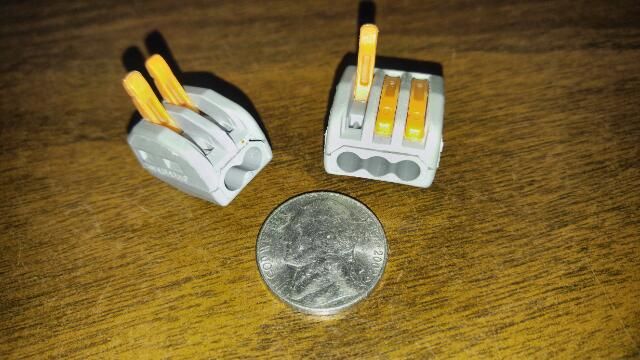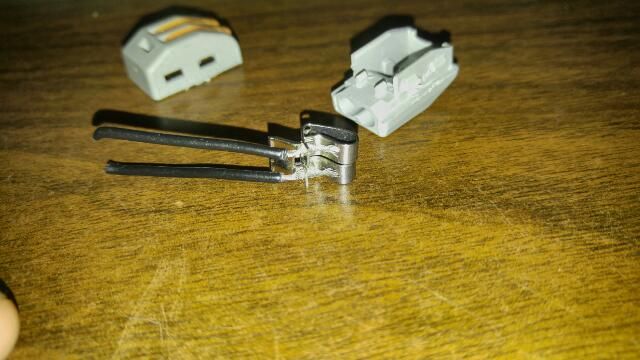|
|
Post by oldgeek on May 23, 2016 17:19:55 GMT -5
Although I use them nearly daily, I do not care for wire nuts. I started seeing what I call cage connectors about 15 years ago in industrial settings, usually bunched together on a DIN rail. I recently found a version of the cage connector on Feebay that works like a wire nut. They grab the wire in a cage and clamp it with just the right pressure and are easily removable and reusable. I stuff more than 1 wire in the hole all the time, so a 2 position can hold 4 wires easily. They are quicker to use and they don't damage the wire like a wire nut does. A couple cons: They are larger than wire nuts, and they cost considerably more than wire nuts.  |
|
|
|
Post by oldgeek on May 23, 2016 17:44:41 GMT -5
I added a picture of the self sizing clamping mechanism. It is clamped until the lever is lifted, so it does not rely on the lever to keep it clamped onto the wire. It forms what is called a gas tight connection.  |
|
|
|
Post by FrankenMech on Aug 29, 2016 3:01:38 GMT -5
Look like WAGO cage clamp connectors to me. Good connectors. I have used them in various configurations on DIN rails, panel mounted, and PC boards since back in the 80's. www.wago.us/ |
|
Deleted
Deleted Member
Posts: 0
|
Post by Deleted on Aug 29, 2016 8:27:30 GMT -5
I just solder the connections and shrink wrap them and be done with it, tired of failed connectors etc.
|
|
Deleted
Deleted Member
Posts: 0
|
Post by Deleted on Aug 29, 2016 9:33:36 GMT -5
I was always taught that wire nuts should never be used in any automotive (or scooter) application due to the vibrations making them come loose over time. They are fine in house wiring but not things that move. I solder when I am able to otherwise just use solderless connectors in heat shrink tubing.
Those connectors pictured look pretty robust to me. Do they make them any smaller? Or various sizes?
Bill
|
|
|
|
Post by FrankenMech on Aug 30, 2016 4:41:27 GMT -5
Follow the link I listed for various connectors.
I have had very good luck with the Wago connectors in high vibration environments.
Solder flux is an acid and we normally don't clean it off of connections. I have seen it cause a lot of corrosion problems.
I wonder what the navy uses for connections nowadays?
|
|
|
|
Post by oldgeek on Aug 30, 2016 5:11:42 GMT -5
I just solder the connections and shrink wrap them and be done with it, tired of failed connectors etc. Soldering and shrink wrap does make a very good connection, but is impractical for a connection you may want to take apart. The DIN rail type wago connector is pretty much the standard for industrial settings now days. They replaced the ones that used a screw. A properly sized and installed wire nut is a VERY good gas tight connection. I have seen them corroded beyond belief in HVAC settings, but they were still making good connection. |
|
Deleted
Deleted Member
Posts: 0
|
Post by Deleted on Aug 30, 2016 7:29:59 GMT -5
I have yet to have any problems associated with soldered joints and what little hassle there is with working with the wiring afterwards is nothing compared to the frustration of being shut down because of a funky connector.
|
|
|
|
Post by iwannascoot on Aug 30, 2016 7:42:06 GMT -5
Solder flux is an acid...
FrankenMech, Rosin is not acid, is it? I never thought about trying to clean off the flux after soldering.
Billy
|
|
Deleted
Deleted Member
Posts: 0
|
Post by Deleted on Aug 30, 2016 9:36:57 GMT -5
Solder flux is an acid... FrankenMech, Rosin is not acid, is it? I never thought about trying to clean off the flux after soldering. Billy Acid core solder is for plumbing (copper pipes, etc.) rosin core solder is for electronics and will not corrode the components. Bill |
|
|
|
Post by FrankenMech on Aug 30, 2016 18:52:47 GMT -5
The rosin core in solder is a weak acid, it's function is to chemically clean the surfaces and it will corrode leads and wires. Cleaning the flux off components and wires is required for high reliability military and aerospace assemblies. Normal commercial soldering processes are cleaned after soldering, just not to the same level of perfection. Industrial or electronic supply houses usually have flux cleaning sprays and liquids for use with rosin core solder.
Plumbing solder has a much stronger acid formulation but the purpose is the same. Cleaning is required after the joint is completed to avoid corrosion.
Soldering and brazing flux products come in many different formulations depending on the application. They all rely on chemistry to clean and prep the surfaces.
|
|
|
|
Post by 190mech on Aug 30, 2016 20:03:38 GMT -5
We have had on going talks about proper connections in the aviation world for many years..The solder guys like the solid connection,gotta heat shrink it though,then its a rigid connection as the solder has produced non flexible joint that'll break on either side with vibrations..I'm a crimp connector fan,with the proper tool and connector the wire still is flexible and is insulated too...  |
|
Deleted
Deleted Member
Posts: 0
|
Post by Deleted on Aug 30, 2016 22:20:38 GMT -5
My dad was a CFI with his A/P, he was a little of both really, but I always tend toward solder, I also solder them spliced inline and keep them spaced apart from other joints so I don't end up with a big blob of splices in the same spot.
|
|
|
|
Post by knobby on Mar 22, 2017 13:14:34 GMT -5
I like posi-lock for reusable inline connectors. They make inline fuses too. If installed properly the connection strength exceeds the wire strength. On permanent stuff I like using crimp connectors with solder.
|
|
|
|
Post by dav3titus on Sept 2, 2017 18:06:10 GMT -5
Hey! If you follow the WAGO link above, they will send you free sample of the connecters!!
|
|